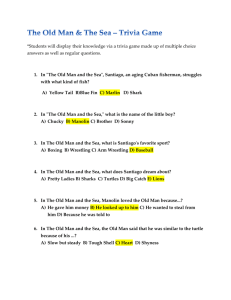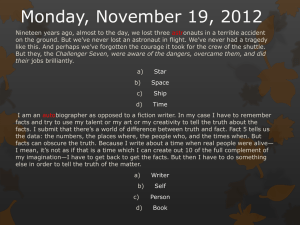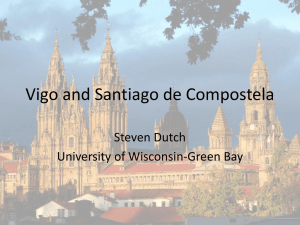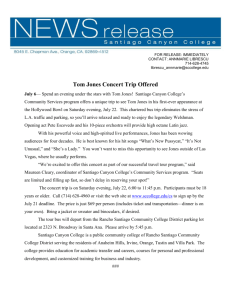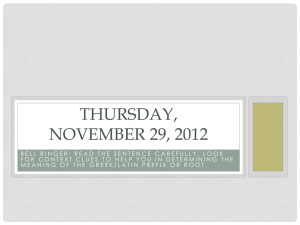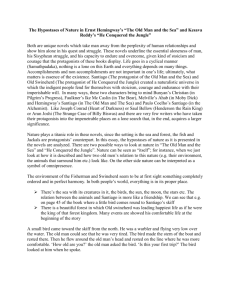Old Man and the Sea Study Guide Answers
advertisement
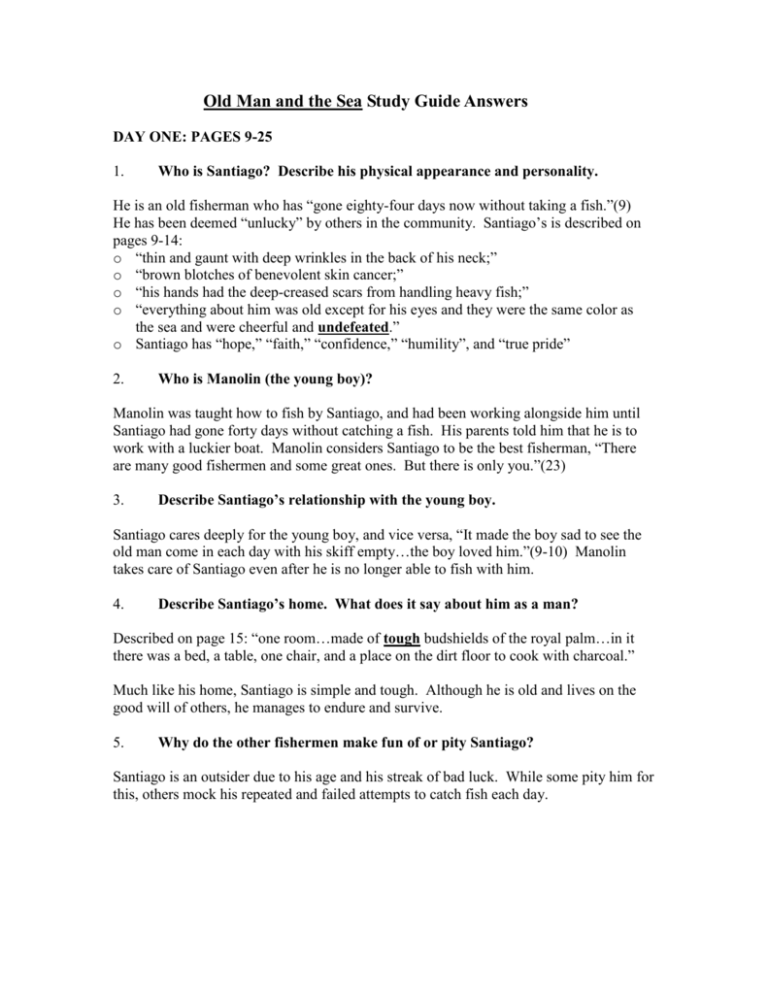
Old Man and the Sea Study Guide Answers DAY ONE: PAGES 9-25 1. Who is Santiago? Describe his physical appearance and personality. He is an old fisherman who has “gone eighty-four days now without taking a fish.”(9) He has been deemed “unlucky” by others in the community. Santiago’s is described on pages 9-14: o “thin and gaunt with deep wrinkles in the back of his neck;” o “brown blotches of benevolent skin cancer;” o “his hands had the deep-creased scars from handling heavy fish;” o “everything about him was old except for his eyes and they were the same color as the sea and were cheerful and undefeated.” o Santiago has “hope,” “faith,” “confidence,” “humility”, and “true pride” 2. Who is Manolin (the young boy)? Manolin was taught how to fish by Santiago, and had been working alongside him until Santiago had gone forty days without catching a fish. His parents told him that he is to work with a luckier boat. Manolin considers Santiago to be the best fisherman, “There are many good fishermen and some great ones. But there is only you.”(23) 3. Describe Santiago’s relationship with the young boy. Santiago cares deeply for the young boy, and vice versa, “It made the boy sad to see the old man come in each day with his skiff empty…the boy loved him.”(9-10) Manolin takes care of Santiago even after he is no longer able to fish with him. 4. Describe Santiago’s home. What does it say about him as a man? Described on page 15: “one room…made of tough budshields of the royal palm…in it there was a bed, a table, one chair, and a place on the dirt floor to cook with charcoal.” Much like his home, Santiago is simple and tough. Although he is old and lives on the good will of others, he manages to endure and survive. 5. Why do the other fishermen make fun of or pity Santiago? Santiago is an outsider due to his age and his streak of bad luck. While some pity him for this, others mock his repeated and failed attempts to catch fish each day. 6. Who does Santiago admire and why? Santiago admires the sport of baseball, and especially Joe DiMaggio of the New York Yankees. He looks up to DiMaggio because his father was also a fisherman, so he may understand the hardships that Santiago is undergoing at the present moment.(22) 7. What does Santiago dream of? Why is this dream important to Santiago? Santiago no longer dreams of women, fish, or of fights, but of “the lions on the beach. They played like young cats in the dusk and he loved them like he loved the boy.”(25) This dream is important to Santiago because it reminds him of his childhood and because the lions are like him, a hunter. DAY TWO: PAGES 25-54 1. Why can the reader consider Santiago a superior fisherman? Give examples. o “He was rowing steadily and it was no effort for him…” (30) o “He kept [the lines] straighter than anyone did…there would be bait waiting exactly where he wished it to be…”(32) o “he was still fishing correctly through faster then he would have fished if he was not trying to use the [man-of-war bird].”(33) o He knows that the flying fish and birds signal a big school of dolphin.(34) o “he was happy to see so much plankton because it meant fish.”(35) 3. How does Santiago describe the sea? How is this different from other fishermen? He refers to the sea as “she” and states that “she is kind and very beautiful. But she can be so cruel…He always thought of her as feminine [la mar] and as something that gave or withheld great favours, and if she did wild or wicked things it was because she could not help them.”(29-30) The younger fishermen refer to the sea “as el mar which is masculine,” when they have had a good day at sea. (30) 4. How does Santiago compare himself to a turtle on page 37? “…a turtle’s heart will beat for hours after he has been cut up and butchered…I have such a heart too and my feet and hands are like theirs.”(37) Like the turtle, Santiago is tough and persistent even in the face of death. 5. How are women portrayed in this novella? Throughout the novella, women are portrayed as having no place in the world. As Santiago continually states, women are cruel and have no control over their own doings. Women are also deemed by Santiago not to be worthy opponents, notice how he refers to the marlin as a “he” even though he has not seen it yet. Numerous examples in this section include: o Pages 29-30 “she can be so cruel…if she did wild or wicked things it was because she could not help them.” o Pages 35-36 Santiago refers to the Portuguese man-of-war as a “whore” because they “were beautiful…but were the falsest thing in the sea and the old man loved to see the big sea turtles eating them.” o Page 49 “…the hooked fish, the female, made a wild, panic-stricken, despairing fight that soon exhausted her..” 6. How does Santiago feel about the marlin? What does it symbolize to him? Santiago comments that the marlin is “wonderful,” “strange,” “strong,” “wise,” and “that his fight has no panic in it.”(48-49) Based on his description of the marlin, Santiago loves and respects him as a worthy opponent and brother, “Now we are joined together and have been since noon.”(50) Santiago is not only literally linked to the marlin, but also figuratively because the outcome of this battle will determine both their fates. 7. Santiago contemplates his choice on page 50. What was this choice? Santiago chose to go “there to find him [the marlin] beyond all people.” (50) His choice was to go far out into the sea, farther than any of the other fishermen. 8. Does Santiago possess any flaws? Santiago possesses one heroic flaw, his pride or hubris. It is his hubris or pride that caused him to choose to go far out into the sea, and it will be his pride that will eventually determine his and the marlin’s fates. DAY THREE: PAGES 54-76 1. How is Santiago similar to the warbler? Like the tired warbler unaware of the hawks that will prey upon him, Santiago is tired and will soon face an attack of his own. The warbler foreshadows Santiago’s looming, yet ultimate fate. 2. Describe the developing bond between Santiago and the marlin. “‘I love you and respect you very much. But I will kill you dead before this day ends.’”(54) Santiago makes this promise at the end of his first day at sea. Although Santiago’s goal is to kill the marlin, he has grown attached to him, “I am with a friend,” states Santiago. (55) He has respect, love, and admiration for his brother and opponent, “I wish I was the fish, he thought.”(640 3. Is Santiago afraid of death? Explain. Santiago is not afraid of death because it is inevitable. If death must come, let it be at the hands of someone worthy because it makes one’s death more honorable and meaningful. 4. Describe the marlin. (62-63) o “His sword was as long as a baseball bat…” o “re-entered [the water], smoothly, like a diver and the old man saw the great scytheblade of his tail…” o “‘He is two feet longer than the skiff’” o “…they are more noble and more able.” 5. What part if his body does Santiago not trust? Why? Santiago no longer trusts his left hand because it cramps up on him making it “humiliating” (62) and “unworthy.” (64) “…his left hand had always been a traitor and would not do what he called on it to do and he did not trust it.”(71) 6. Why does Santiago worship baseball and Joe DiMaggio? “I must be worthy of the great DiMaggio who does all things perfectly even with the pain of the bone spur in his heel.”(68) He worships DiMaggio because he overcomes the pain of his bone spur to play exceptional baseball, a measurable sport, which allows one to accurately determine a man’s worth, much like Santiago is measured by the number of fish he does or does not catch. 7. How does Hemingway develop Santiago as a Christ-like figure? o “The old man carried the mast on his shoulder and the boy carried the wooden box…”(15) o Santiago is an outcast; all alone at sea o “…noticed his hand was bleeding.”(56) o “‘Christ…I’ll kill him though. In all his greatness and his glory.’”(66) o Declares the marlin his brother, so they have similar fates 8. What is man’s place in nature? In the life cycle? Santiago feels at home in nature, “…he knew no man was ever alone on the sea.”(61) Santiago feels a deep connection to nature, a brotherhood, “But it is good that we do not have to try to kill the sun or the moon or the stars. It is enough to live on the sea and kill our true brothers.”(75) He feels that nature and its creatures are nobler and have more dignity, and that is why Santiago feels that the people are not “worthy of eating [the marlin].” (75) DAY FOUR: PAGES 76-122 1. What does it mean to be a man or “to suffer like a man”? (92) “To suffer like a man” means to ignore the pain, “‘…pain does not matter to a man;’” (84) remain calm; keep one’s head clear; and be fearless. 2. Why does Santiago “not care who kills who”? (92) Because Santiago views the marlin as a brother and worthy opponent, he values the battle which develops between them. The marlin, his opponent, brings out the best in Santiago, his power and bravery, his love and admiration for others. To Santiago, it is better to die at the hands of a worthy opponent. 3. How does the marlin transcend his death? (94) “Then the fish came alive, with his death in him, and rose high out of the water showing his great length and width and all his power and his beauty.”(94) Although the marlin dies, his death brings new life to Santiago, who will be considered a hero when he returns to the village. Thus, the marlin lives on in Santiago. 4. How is the Mako Shark similar to the marlin? How is it different from the shovel-nosed sharks? “He was a very big Mako shark built to swim as fast as the fastest fish in the sea and everything about him was beautiful…had no other enemy…had no fear.”(100-01) Like the marlin, the Mako shark is a worthy opponent because Santiago “enjoyed killing [it].”(105) The shovel-nosed sharks “were excited and in the stupidity of their great hunger they were losing and finding the scent in their excitement…They were hateful sharks, bad smelling, scavengers, as well as killers…But they had not come as the Mako had come.” (107-08) 5. How does Santiago feel about hope? (104) “It is silly not to hope, he thought. Besides I believe it is a sin.”(104-05) Without hope, Santiago has no reason to endure the sharks or his difficult voyage back to the village. One needs hope in order to endure life’s difficulties. 6. Why can Santiago not look at the mutilated marlin? “When the fish had been hit it was as though he himself were hit.”(103) It pains Santiago greatly to see his brother mutilated because of his pride, “I did it to keep me alive and to feed many people.”(105) Because of his pride, he sailed out too far, which puts him and the marlin in jeopardy. (110) 7. How does Hemingway continue to develop Santiago as a Christ-like figure? “…it is just a noise such as a man might make, involuntarily, feeling the nail go through his hands and into the wood.” (107) Christ perhaps made the same noise when nails were driven through his hands and into the cross. 8. How does Santiago justify what he has done to the marlin? Do you feel he is justified? Why or why not? Santiago justifies killing the marlin by saying that it is the natural order of things, “You were born to be a fisherman as the fish was born to be a fish.” (105) He continues to justify his actions by stating, “You loved him when he was alive and you loved him after. If you love him, it is not a sin to kill him.” (105) Again, he believes he is justified because he loves and respects the marlin even after his death. 9. Do you feel that the marlin has died in vain? Why? 10. Explain the significance of: “The boy keeps me alive.” (106) Because of his age, this will probably be Santiago’s last chance to catch such a great fish as the marlin. Although his fishing career is coming to a close, Santiago will figuratively live on in Manolin because he taught him how to fish. DAY FIVE: PAGES 122-128 1. Explain: “A man can be destroyed but not defeated.” (103) Was Santiago defeated by the shovel-nosed sharks? Santiago was NOT defeated by the shovel-nosed sharks because the decimated marlin still brings Santiago recognition from the other fishermen, “Many fishermen were around the skiff looking at what was lashed beside it…” (122) This recognition renews Santiago’s fishing career and brings him new respect from his peers. 2. Although Santiago will probably never have the chance to catch another big fish, how does he transcend “the death” of his fishing career? Santiago will transcend “the death” of his fishing career through the young boy, Manolin. Because Manolin is Santiago’s devoted apprentice, everything that Santiago has taught him about fishing will live on in the young boy. 3. Why is it significant that the novella ends with Santiago dreaming of the lions? The dream of the lions stems from Santiago’s boyhood travel to Africa. As Santiago’s life is drawing to a close, it is appropriate that he dreams of the lions from his childhood, thus his life has come full circle from his birth to his death. 4. How does Hemingway develop the theme that there is honor and beauty in defeat? Honor and beauty stemming from defeat is seen when the marlin is caught by Santiago and mutilated by the sharks. Even when facing inevitable death, the marlin’s determination makes him honorable and beautiful. Santiago is very similar to the marlin. Even when facing devastating odds, Santiago endures and becomes a hero in the eyes of Manolin, his fellow fishermen, and the tourists. 5. How is pride seen as a virtue? It is Santiago’s pride that causes him to go far out into the sea and catch the marlin. If not for his pride and determination, Santiago would not have received the glory and honor from those in the village. 6. How is the idea that life comes from death illustrated in the novella? Santiago’s fishing career is reinvigorated by the death of the great marlin. Even after death, Santiago will live on in the young boy, Manolin. 7. What does the marlin come to symbolize for Santiago and his life as a fisherman? The marlin comes to symbolize Santiago’s ultimate opponent and his renewed glory and honor in the village.
